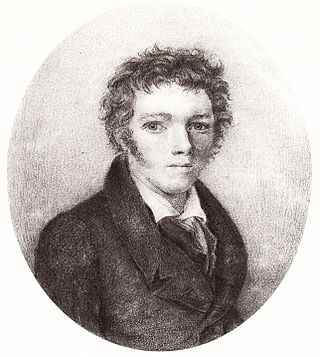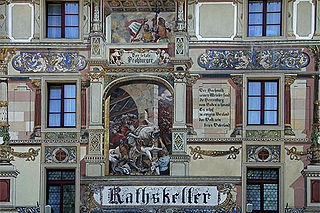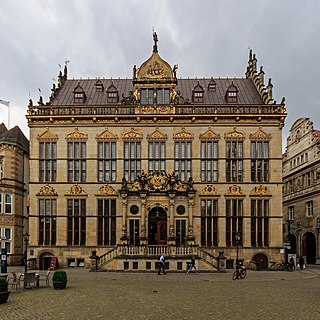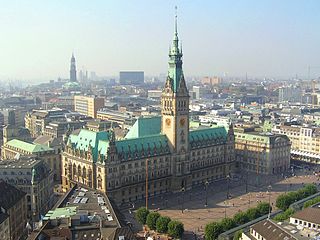
Wilhelm Hauff was a German poet and novelist.

Tokaj is a historical town in Borsod-Abaúj-Zemplén county, Northern Hungary, 54 kilometers from county capital Miskolc. It is the centre of the Tokaj-Hegyalja wine district where Tokaji wine is produced.

Ratskeller is a name in German-speaking countries for a bar or restaurant located in the basement of a city hall (Rathaus) or nearby. Many taverns, nightclubs, bars and similar establishments throughout the world use the term.

Bremen, officially the City Municipality of Bremen, is the capital of the German state of the Free Hanseatic City of Bremen, a two-city-state consisting of the cities of Bremen and Bremerhaven. With about 570,000 inhabitants, the Hanseatic city is the 11th largest city of Germany and the second largest city in Northern Germany after Hamburg.

The New Town Hall is a town hall that forms the northern part of Marienplatz in Munich, Bavaria, Germany. It hosts the city government including the city council, offices of the mayors and a small portion of the administration. In 1874 the municipality had left the Old Town Hall for its new domicile.

Bremen City Hall is the seat of the President of the Senate and Mayor of Bremen, Germany. It is one of the most important examples of Brick Gothic and Weser Renaissance architecture in Europe. Since 1973, it has been a protected historical building. In July 2004, along with the Bremen Roland statue, the building was added to the list of UNESCO World Heritage Sites because of its outstanding architecture and its testimony to the development of civic autonomy in the Holy Roman Empire.

The City Hall is a historical building in Cologne, western Germany. It is located off Hohe Straße in the district of Innenstadt, and set between the two squares of Rathausplatz and Alter Markt. It houses part of the city government, including the city council and offices of the Lord Mayor. It is Germany's oldest city hall with a documented history spanning some 900 years. The history of its council during the 11th century is a prominent example for self-gained municipal autonomy of Medieval cities.

The Vorbunker was an underground concrete structure originally intended to be a temporary air-raid shelter for Adolf Hitler and his guards and servants. It was located behind the large reception hall that was added onto the old Reich Chancellery, in Berlin, Germany, in 1936. The bunker was officially called the "Reich Chancellery Air-Raid Shelter" until 1943, when the complex was expanded with the addition of the Führerbunker, located one level below. On 16 January 1945, Hitler moved into the Führerbunker. He was joined by his senior staff, including Martin Bormann. Later, Eva Braun and Joseph Goebbels moved into the Führerbunker while Magda Goebbels and their six children took residence in the upper Vorbunker. The Goebbels family lived in the Vorbunker until their deaths on 1 May 1945.

The New Town Hall is a town hall on the Schlossplatz in Wiesbaden, Hesse, Germany. It hosts the city government including the city council, offices of the mayors and part of the administration. It was built between 1884 and 1887 by Georg von Hauberrisser in a Renaissance Revival architecture style. The basement is almost completely occupied by a restaurant called Ratskeller.

Georg Wrba was a German sculptor and graphic artist. He created some 3,000–4,000 works, including as a collaborator of the Zwinger workshop.

The old Rathscafé, now named Deutsches Haus, is a listed building on the market place (Marktplatz) in Bremen. It is part of the monument ensemble No. 1–21.

The Bremer Marktplatz is a square situated in the centre of the Hanseatic City of Bremen. One of the oldest public squares in the city, it covers an area of 3,484 m2 (37,500 sq ft). It is no longer used as a market place except for the Christmas market and the annual Freimarkt Fair at the end of October.

The Schütting, situated on the Marktplatz in Bremen, initially served the city's merchants and tradesmen as a guild house. In 1849, it became Bremen's chamber of commerce. Since 1973, it has been under monument protection. It lies on the south site of the Bremen marketplaces directly across from the town hall.

The New Town Hall has stood on the Domshof in the centre of Bremen, Germany since 1913. Located behind the Unser-Lieben-Frauen-Kirchhof cemetery, it is adjacent to the older section of the Town Hall with which it forms a harmonious ensemble. Among its sumptuous rooms decorated with local artefacts, the New Town Hall houses the Senate Chamber used by the Senate for its regular meetings and the Great Hall, a venue for official receptions. In 2004, Bremen Town Hall was listed as a UNESCO World Heritage Site, together with the Roland of Bremen, because of its outstanding architecture and testimony to the development of civic autonomy during the Holy Roman Empire.
The Bremen Exchange in Bremen was one of the eight German Regional stock exchanges until 2007. In 2000 it ceased to use the Open outcry method and in 2007 the last operative units were closed. The property of exchange's holding company went to the newly established Foundation of the Bremen Stock Exchange, a non-profit organisation which is intended to benefit scholarship, research, and culture.

Unser Lieben Frauen Kirchhof is a central square in Bremen between the Bremer Marktplatz, Obernstraße, Sögestraße and the Domshof. The square is used as a flower market. The appearance of the square is quite consistent: sandstone, dark brick and clinker brick.

The Old Town Hall is the former town hall in the centre of the city of Oldenburg, Lower Saxony, Germany.

Rathausmarkt is the central square of Hamburg, Germany, located in the Altstadt quarter right in front of the Hamburg Rathaus. Framed by shopping arcades of Alsterarkaden at Alsterfleet, there are many events taking place here, amongst them open air cinema in summer, the Stuttgarter Weindorf, the music festival of Rockspektakel, and the Christmas market in December.

The Old Town Hall is a former, and the first, town hall in Hanover, Germany. Originally built in the old city district in 1410, replaced by the New Town Hall in 1913, and extensively restored in 1953 and 1964 after heavy bomb damage in World War II, it is the oldest secular building in the city. The market façade with the highly sophisticated Brick Gothic of the lucarnes has been preserved and partly restored in its medieval shape. Some elements of it were copied on other wings of the building.
Heinrich Schlitt was a German painter and illustrator, known for his fantasy motifs that feature gnomes, dwarves, and faeries. He was one of the in-house artists at the Villeroy & Boch ceramic company in Mettlach, Saarland, and his designs for their beer steins remain popular with collectors to this day.





















